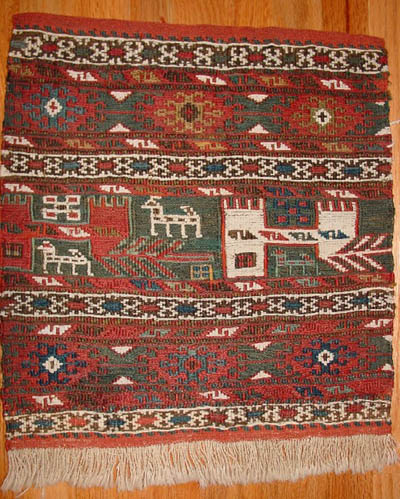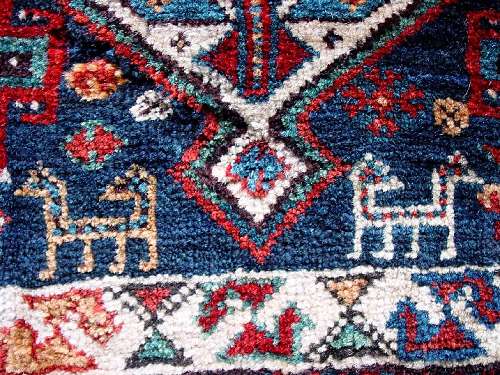Posted by Patrick Weiler on 12-10-2004 11:34 AM:
Fragment of a bird?
Here is a piece of a bag. I believe it to be Kurdish. It could be
Shahsavan.
Notice that there are several quadrupeds in the central panel.
They are interspersed around and between a couple of larger, upside-down
animals.

Here is a close-up showing one of the upside down
animals

This motif appears to be a modified version of what is called a
"bird" in numerous Shahsavan weavings.
Did the weaver just not know that
these animals are upside down and usually have a beak? Or did she weave this
having seen only a fragment of a complete example?
Or was there a reason for
de-beaking the birds and placing them upside-down, such as showing subjugation
of the originator of the design?
Here is the back, in case it
helps!

Patrick Weiler
Posted by Richard Tomlinson on 12-10-2004 08:54 PM:
Hi Patrick
I cannot answer your questions regarding the birds, but I
have noticed that the quadrupeds have their feet facing backwards.
This
is an irregular feature when compared to all of the Shahsavan examples I have
looked at. Most face forewards, or are simply straight, with no feet. Some have
are straight with 'socks' (a change in colour)
Regards
Richard Tomlinson
Posted by Louis Dubreuil on 12-11-2004 05:39 AM:
birds?
Except for the feather device those bizarre forms have not great affinities
with birds.
The only thing we can say about them is that they look like
fantactic creatures with to groups of four "legs". In the eastern bestiary
fantastic creatures are often "dragons". As nobody never see dragons all is
possible.
meilleures salutations
Louis dubreuil
Posted by Steve Price on 12-11-2004 05:44 AM:
Hi Pat
The large devices are not upside down birds, they are
motorboats. The propeller is obvious.

Regards
Steve Price
Posted by Richard Tomlinson on 12-11-2004 06:44 AM:
Hi again Patrick
You wrote:
"Here is a piece of a bag. I
believe it to be Kurdish. It could be Shahsavan"
Firstly, I would be more
inclined to think it is a mafrash panel rather than a bag.
Secondly, it
looks very similar to pieces that have been attributed to Shahsavan weavers. You
are obviously more inclined towards a Kurdish attribution. May I ask why? I am
guessing colour.
Regards
Richard Tomlinson
Posted by Wendel Swan on 12-11-2004 07:33 AM:
Hi Pat,
Yours is certainly, as Richard suggests, a mafrash end panel.
It was done in Karabagh, most likely by the Azeri Turks. These panels are seldom
fine, but the design would circumscribe the complete mafrash.
The
weaver(s) did not or could not execute some of the details of the larger
animals, including the head and mouth, but I do not think they derive from the
dragon motifs. Both brds and quadrupeds are often seen on mafrash and khorjin.
Perhaps these big guys could be referred to as bi-genus.
I would guess it
to be second quarter of the 20th Century.
Best,
Wendel
Posted by Patrick Weiler on 12-11-2004 08:53 PM:
Kurd for sure
Richard,
It is obviously a Kurd because the tag says so!

Or maybe it says "Burd", I
can't really tell.
I have seen a few examples of "bird" weavings labelled
Kurd. I will be glad to call it whatever makes it worth more 
Karabagh Azeri Turk certainly sounds
more exotic than simply Kurd, Wendel.
And, yes, it is most likely the
end panel of a mafrash. The "top" is folded over and sewn down as would be with
a mafrash. There is no closure strip.
As for the date of mid 20th
century, it does have some wear to the cotton whites, which is not uncommon to
Shahsavan weavings. It certainly looks better than I do for being mid-20th
century.

It was
probably not made as a "fake" piece, so it may have been made at the tail end of
a long weaving tradition. The birds without beaks may have lost them due to the
size of the central panel not being big enough. The rest of the design of these
eight-legged creatures follows the "norm" quite closely.
I will post a
picture from the Wertime book soon. I exported the photo to Jordan for
processing at the Filiberto Foto and Painting Repair Laboratory, so it needs to
pass through customs before I can post it.
Patrick Weiler
Posted by Patrick Weiler on 12-12-2004 02:39 AM:
Copy Cat
Here is a photo of plate 97 in John Wertime's book, Sumak Bags of Northwest
Persia and Transcaucasia:

And the close up of my piece for comparison:

Notice that the feet
on the quadrupeds are facing forwards, not backwards as in my example. This
would be another reason, besides the headless upside-down Large Animal Figures
(Wertime's description) in my piece compared to the elegantly eared, eye-balled
and beaked "Octoped" (my description) creatures in John's piece, to consider
that my piece is "removed" from the origin of this design. Perhaps just by age,
or perhaps by tribe. Nearly all other aspects of the design have been retained.
The same major and minor borders, the same small filler devices such as the
"dice"and "quartered squares".
Both pieces have a band of "S" motifs in the
bodies of the Octopeds.
Wertime notes the "less fine and smooth" extra weft
wrapping, especially in the borders and guard stripes, compared to other
Moghan-Savalan area examples, leading him to wonder if his example was either
not as old as the others or possibly the weaving practices of this community
were responsible. My piece also has less fine weaving than other pieces I own.
You could call it "robust" weaving rather than fine weaving.
So, was this
design borrowed by the Karabagh Azeri Turks from the Moghan-Savalan Shahsavan,
leading to these curious changes? Why are the Large Animal Figures in my piece
upside down and missing their heads?
Here is a picture of a couple of
two-headed creatures from a Khamseh saddlebag. Note that the one on the left has
forward-facing feet and the one on the right has backward-facing feet. Early
genetic engineering?


I
suspect more examples of this odd genetic engineering will turn up in other
weavings.
I guess that the only conclusion one can come to is that my
piece is one of the end panels of John's piece. 
Patrick Weiler
Posted by Richard Tomlinson on 12-12-2004 05:42 AM:
Hi Patrick
As I said before, it seems to be more common (like 95%+ of
examples I have looked at) for quadrupeds to have their feet facing forward.
Often, these quadrupeds are placed in random positions.
I have noticed
in a small number of pieces that some quadrupeds do have their feet facing
backwards. But these examples usually have quadrupeds placed in 4 corners -
around a design.
I'd be interested to know of your Khamseh saddlebag
has 4 animals arranged roughly in a square around a medallion.
You also
say that the animals in the Khamseh saddlebag example are 2-headed. I would
think that one 'head' is actually some sort of tail - just that the design is
not precise enough.
Regards
Richard Tomlinson
Posted by Richard Tomlinson on 12-12-2004 06:43 AM:
OK, I am going to retract my comments about feet. I think I have put my foot
in it :-0
I have just had a good look through all of my books.
It
appears that the general trend is for forward facing feet, but there are
examples - some old ones too - where the feet face backwards.
There
appears to be no pattern. I am not sure we can even say that backward facing
feet are a degeneration of design.
And the quadrupeds in the Khamseh
saddlebag example may actually have two heads.
Richard Tomlinson
Posted by Patrick Weiler on 12-12-2004 04:58 PM:
Funny Feet
Richard,
Here is the full bag, with two-headed quadrupeds in each
corner:

Here is
the half of the bag with the quadrupeds from my earlier post at the bottom. The
design is one usually associated with Qashqai weavers, but I believe this to be
an early 20th century Khamseh version. It is known as the "Nuclear Reactor"
design. You can easily see the blue fuel rods in the red reactor "core", with
the super-heated red water surrounding it and being routed to the lighter blue
cooling ponds at the perimeter. The so-called "Memling" guls are actually a
diagram of the uranium atom undergoing fission, with Alpha and Beta particles
(also known as "rosettes") flying away around each atom. The Alpha particles are
the larger rosettes:

And here is a close-up of the top of this face of the bag,
showing a truly confused (obviously radiation induced two-headed) quadruped with
three feet facing one direction and one going the other way:

You might notice a "crease" running
right along these creatures' foreheads. That is because the weaver miscalculated
somewhere along the line and made this face too long. That required it to be
folded over, so a couple of inches of pile is on the back.
Patrick
Weiler
Posted by Richard Tomlinson on 12-12-2004 07:32 PM:
Patrick
You forgot to mention that the main border is clearly a razor
wire fence, hence the positioning of the quadrupeds. They are clearly 'guard
dogs' of some type, patrolling the perimeter.
Regards
Richard
Tomlinson
Posted by Patrick Weiler on 12-13-2004 12:18 AM:
Unbelievable
Richard,
Don't be ridiculous. Barbed wire wasn't invented until the
19th century!
The outer border is a group of politicians trying to decide
what to do. 
Patrick
(from a blue state ) Weiler













